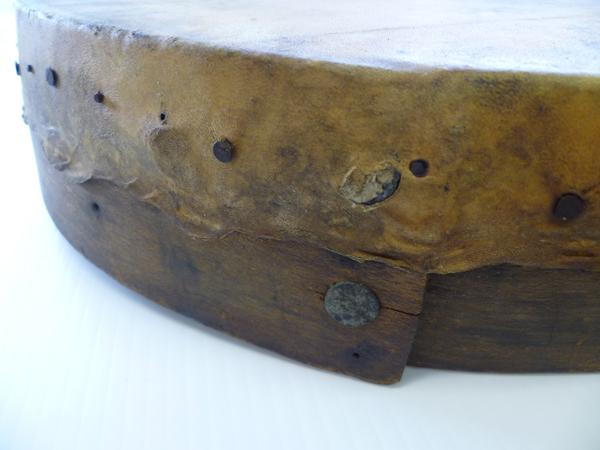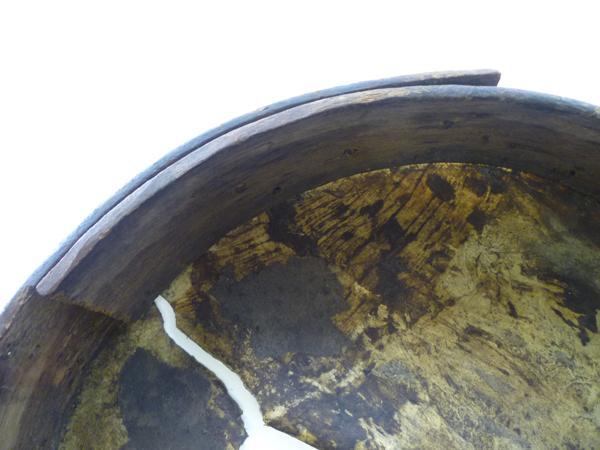c.1820
Bodhrán
A nineteenth century example of an Irish musical instrument.
By Noel CampbellDescription
This bodhrán (pronounced bough-rawn), also called a dallán in Irish, consists of a hoop of flexible wood forming a shallow cylinder one end of which is covered with white leather, probably sheep or goat skin. It is 41cm in diameter and 8.5cm deep. The wood of the rim is 5mm thick. The ends are overlapped for a distance of 20cm and are fastened with nails. The skin reaches up the side of the instrument for about 5cm and is secured by a row of tacks. The skin has historical damage including a large jagged tear to one side of the centre. As a result, this object has been brought to the attention of our Conservation Department. The NMI acquired this object in 1942.

How is a bodhrán played?
The bodhrán is a single-headed, frame drum. The musician usually rests the instrument on their knee and holding the cross-piece on the open back of the bodhrán with one hand, they strike the skin with a short double ended stick also known as a tipper or a bone. This particular bodhrán does not have a cross-piece. When the tipper is struck on the bodhrán skin a thudding sound is produced. The name bodhrán may be derived from the Irish word bodhar meaning ‘deaf’ and ‘dull-sounding’.

The bodhrán’s use in Irish festivals
The bodhrán as an instrument was played throughout the year. This bodhrán was made in c.1820 by a man in Killinarden, Tallaght, Co. Dublin. It was used for general dancing and during the Brídeóg celebrations. Brídeóg celebrations occurred on St. Brigid’s Day (Lá Fhéile Bríde), the 1st February. Residents would dress up in fancy dress and walk their locality carrying an effigy of St. Brigid (which was known as a brídeóg) and playing music for their neighbours. The festival atmosphere was used to mark the changing of the seasons from winter to spring. Other Irish customs related to St. Brigid’s Day include the making of St. Brigid’s crosses. The ritual playing of the bodhrán is also associated with Irish festivals on May Day (1st May) and St. Stephen’s Day (26th December).
Learn more
The NMI’s Folklife collection contains a number of bodhráns. This bodhrán is not on public display.
You can find more information in the following:
Hannigan, Steáfán, 1991. The Bodhrán Book, Cork: Ossian Publications Ltd.
Ó Súilleabháin, Mícheál, 1984. The Bodhrán, Dublin: Walton's Musical Instrument Galleries.
Schiller, Rina, 2001. The Lambeg and the Bodhrán, Belfast: Institute of Irish Studies, Queen's University of Belfast.
Location:
Bodhrán is located at:
In Storage
Previous artefact:
Next artefact:
